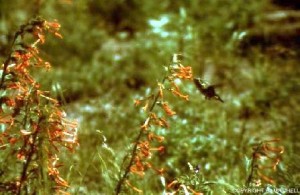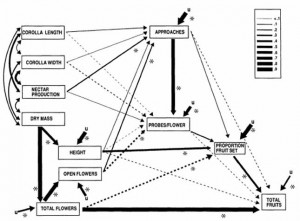…as it relates to plant pollinator interactions and evolutionary ecology.
Visit the Integrated Bioscience Program at The University of Akron
 One example of the benefit of bringing integrative principles to bear on biological questions can be seen in study of how pollinators affect the evolution of plant traits, such as those of the Scarlet Gilia (Ipomopsis aggregata) flowers shown above, visited by a female broad-tailed hummingbird in the Rocky Mountains. Applying new statistical approaches (originated in Biology and expanded and improved in the Social Sciences) to biological data can provide new insights (Mitchell 1992, 1994, Scheiner et al. 2000), and illustrates the benefits of connections between widely disparate fields of science.
One example of the benefit of bringing integrative principles to bear on biological questions can be seen in study of how pollinators affect the evolution of plant traits, such as those of the Scarlet Gilia (Ipomopsis aggregata) flowers shown above, visited by a female broad-tailed hummingbird in the Rocky Mountains. Applying new statistical approaches (originated in Biology and expanded and improved in the Social Sciences) to biological data can provide new insights (Mitchell 1992, 1994, Scheiner et al. 2000), and illustrates the benefits of connections between widely disparate fields of science.
Figure legend. Path analysis diagram illustrating use of structural equations modeling to understand the influence of plant traits (such as nectar production and plant height) on pollinator visitation, and of those jointly on plant reproductive success. Line width represents the strength of the effect, dashed lines indicate negative effects, stars indicate statistical significance. Experimental manipulation of nectar production rate and open flosers confirms the hypotheses suggested by this analysis (Mitchell 1995, Brody and Mitchell 1997)
There are many other connections to be made between work by those in my lab, and the tools provided by other fields of study. They generally start with a strong biological/ecological/evolutionary question, and lead to connections with other fields of study that provide tools to make new progress on the questions. Some other examples beyond the statistical connection outlined above include
- Mathematical modeling (analytical and computational) to understand pollen carryover and multiple paternity. This work is ongoing, in collaboration with Will Wilson, Duke University.
- Pollen-pistil interactions as determinants of siring success. Could connect to chemistry, biochemistry, plant physiology.
- Geographical patterns of ecological interactions (geography, geology)
- Conservation biology- could connect with economics, law, geography, engineering, geology and others
I welcome inquiries from students interested in these and other connections.
Randy Mitchell

